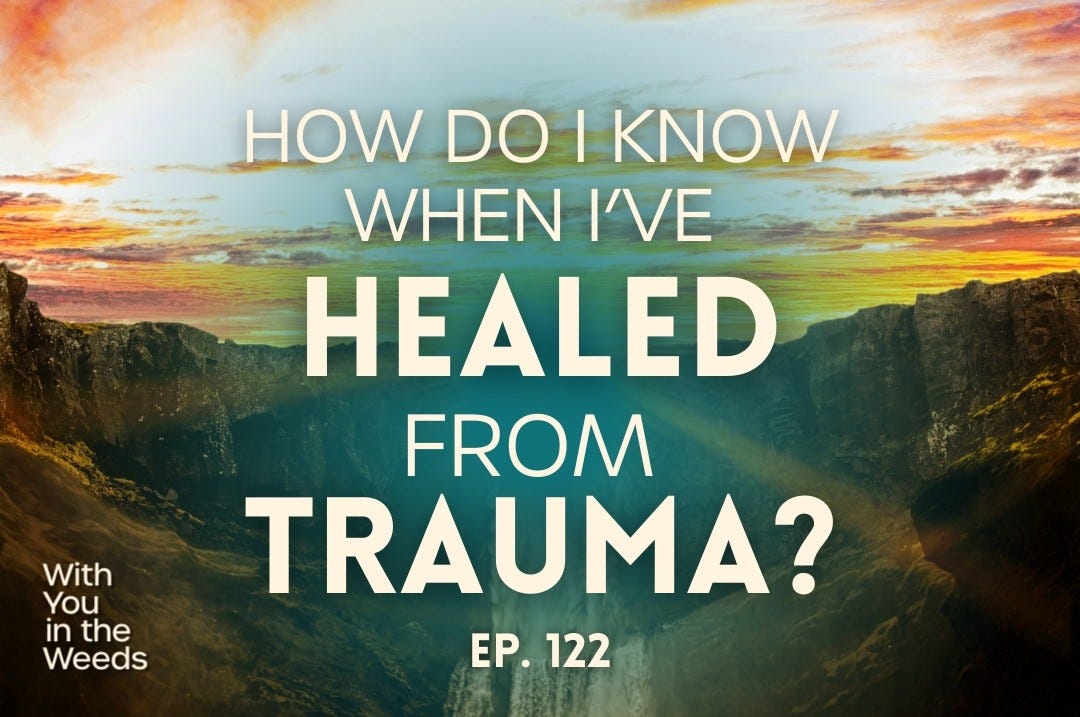How Do I Know When I've Healed from Trauma?
Healing is a journey, not a destination
We are so honored and excited to be nominated for Best Local Podcast 2025 in Inside Columbia Magazine. Voting will continue through April 30th. You can VOTE DAILY!
In the final episode of our Surviving and Thriving After Trauma series, John, Lynn, and Austin answer listener-submitted questions about trauma, healing, and resilience.
Their conversation highlights helpful insights from our trauma series, including:
Definitions and perspectives on trauma
Understanding the impact of trauma on ourselves and our loved ones
Starting the important journey of healing from trauma
You won’t want to miss this episode where we recap the most important takeaways from our trauma series. Our prayer is that this series has helped you manage, endure, and recover from the loss, pain, grief, and hardships that you have encountered.
As with other episodes in this series, some topics can be triggering. Listen as you are able and be sure to have someone safe you can talk through if needed.
Answering Your Questions About Trauma
Question #1: Are some traumas worse than others?
When we define ‘trauma’ as something that overwhelms our body’s ability to cope, there are some similarities with all traumatic events. All traumas have an impact on our physical bodies. More than that, they affect us mentally, emotionally, and spiritually.
But there are qualitative differences to traumatic events as well. Some events are lowercase-t traumas and may not even present as trauma – being teased, ostracized, or mocked. Then there are capital-T traumas, like being abused or neglected as a child, being betrayed, losing a loved one, receiving a terminal diagnosis, or being the victim of domestic violence or assault.
Over time, every trauma can be worked through and processed in the context of a safe relationship. But that healing is going to look different and potentially take longer depending on what the trauma is and how the person responded to it.
The impact of trauma comes down to these two factors:
The nature of the trauma itself: capital-T or lowercase-t
The degree to which you have safety and resources to help you process the trauma
Question #2: What should you say (or not say), to someone who has just experienced a traumatic event?
As therapists, we advise you to be patient and enter in to someone’s suffering in the immediate aftermath of a tragedy rather than try to give advice or downplay their response or reaction. Your role is not to heal someone or ‘solve’ their trauma bundle. Your role is to be a supportive and engaged presence.
Your role is not to heal someone or ‘solve’ their trauma bundle. Your role is to be a supportive and engaged presence.
Here are some do’s for offering comfort:
Enter their world. Be prepared to do more listening than speaking – and if they are in shock and can’t speak about what happened, just sit with them.
Be fully present. Make eye contact. Let them know with your body language and your words that you are “with them”.
Affirm and ask: “I’m with you…what do you need right now? Would you like to talk about what happened?” If they don’t want to talk, be a comforting presence.
Normalize their feelings by asking them to name them. If they can’t, do a simple body scan by asking them, “Where do you feel hurt right now? If that hurt could talk, what would it say?”
Be patient - healing takes a long time. The path of grief is not a quick and linear trajectory. They may have mood swings, changes in behavior, and sometimes seem to move backwards as they recover.
Follow-up by checking in on them periodically. Encourage them to seek professional help.
And some don’t’s:
Don’t use the Bible as a seasoning: “Where can I sprinkle some Bible verses?” Instead, weep with those who weep. Pray with them. Ask them if there are any Scriptures that they find comforting.
Don’t give advice unless asked - or you get permission.
Don’t say “I know how this feels”...even if you’ve been through something similar.
Question #3: What skills do I need to be able to work through trauma in my life and help others as well?
Understand your nervous system and triggers and learn the language of emotion and the skill of self-regulation. Trauma can disconnect you from your body. The more you know about the brain, and what it signals to your body to do in the face of a threat, the better equipped you will be to identify what you’re feeling, and then let those emotions move through your body and release them.
Develop a strong intuition of who a safe person is and isn’t. When you’ve been through something painful, especially experiencing harm at the hands of another person, you can think that “what is familiar is normal”. Read the book Safe People by Henry Cloud and begin to seek out healthy people that can listen, validate, and not try to control you.
Learn how to ask to get your needs met in healthy ways. Reach out to your safe person and say, “I’m really struggling. Today is a hard day. Can we set up a time to meet for coffee?” Recognize when you’re having distressing feelings, and work on being vulnerable to let others in and love you and comfort you.
Become knowledgeable about what the Bible has to say about suffering and hope. Lean into the promises of God and the union you have with Christ as someone who suffers with you and beside you.
Question #4: How do I know when I’ve healed from my trauma?
We’re going to switch this question around a bit. Healing is a journey, not a destination. So instead, we’re going to ask it this way: “How do I know when I’m healing?”
First, healing looks different for everyone. People are complex, with unique personalities, strengths, weaknesses, and experiences. Everyone has different family systems and relationships. Focus on your own healing journey and don’t compare or measure yourself against others.
Second, there are some common signs of healing to look for even as you heal on your own timeline:
Based on what you know about what happened to you in the past, you are able to tell the story of it from the beginning, the middle, and the end in a coherent way. As opposed to starting in one place, jumping to another place, then talking about a completely different topic. Those are signs that things are still fragmented and need to be worked through.
When you can genuinely acknowledge the impact of what’s happened to you without minimizing, dismissing, rationalizing or downplaying. Instead, a healthier response is, “Yes, this happened to me. It was really hard. It hurt a lot. And it wasn’t okay.” Period.
When you can hold any and all appropriate people/parties responsible for what happened. For example, if you experienced sexual abuse from a relative growing up, you genuinely know and believe and assert “The abuse was not my fault, it was their fault.” It can be hard to believe that at first. But that kind of abuse is never the victim’s fault, it’s always the abuser’s fault.
When you can hold on to hope. Sometimes you feel hope, but other times you don’t. Hope as a believer is an objective reality. Based on God’s promises, you know that you’re seen, soothed, safe and secure. But there will be times that you have to wrestle to hold on to hope.
Ways to continue the healing process
Meditate on the sufferings of Jesus. You are not alone! Jesus sees you and is with you.
Familiarize yourself with the Psalms: the language of lament, grieving, groaning, longing. This is a map to follow in your healing journey.
Voice your pain, heartaches, fears to your Heavenly Father because he cares for you and has compassion towards you.
Remember the faithfulness of the Lord. It says in Lamentations 3:23, “The steadfast love of the Lord never ceases; his compassions never fail. They are new every morning; great is your faithfulness.”
When you allow trials, traumas, and sufferings to be transformed by the love and grace of God, you will grow in wisdom and mature in character. Over time you will realize that your soul no longer has an earthly home. Your true home is in heaven, where true health and wholeness are waiting for you. Being assured of this promise, we say “Come, Lord Jesus, come”.
Listen to the entire conversation here:
Recommended Resources:
On the Threshold of Hope – by Diane Langberg
Safe People – by Dr. Henry Cloud & Dr. John Townsend




